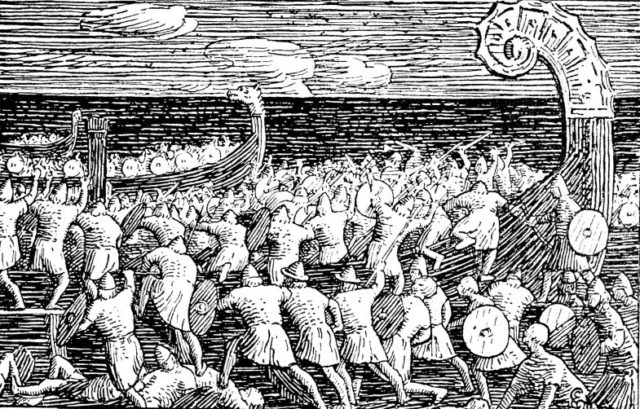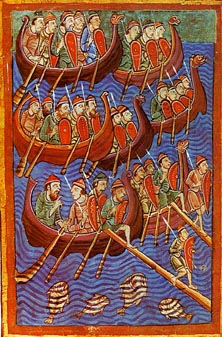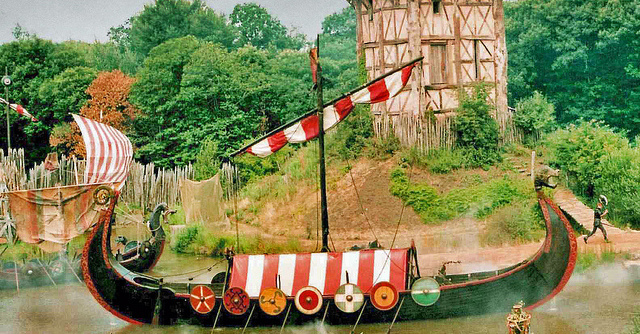The end of the first millennium AD saw a turning point for England. After decades of security, the independent kingdom once again came under attack from Scandinavian raiders, leading to its conquest by the Danes.
A Weakened England
After the English defeated their neighbours in the Battle of Brunanburh in 937, they were left safe from Viking raids for over 40 years. Their defensive measures and demonstration of might had bought them a reprieve after years of attacks.
In 980, this came to an end. The death of King Edgar in 978 put his underage son Aethelred the Unready on the throne. Viking attacks began again, gaining an intensity greater than any seen before.
The Norman Connection
One factor supporting the growth in raiding was the presence of the Normans, a people of Viking descent, on the far side of the English Channel. Having settled in northern France, the Normans became a power in their own right. They had friendly relations with many Scandinavians and provided a safe place for Viking raiders to sell the spoils of war.
Aethelred tried to deal with this in several ways. In 991, the Pope negotiated a peace between England and Normandy. Later in the 990s, the English tried raiding the Norman coast. In 1002, Aethelred married the Count of Normandy’s daughter, hoping that the diplomatic marriage would close the Vikings out of the Norman ports.
None of this did anything to reduce the raids.

English Defences
England was not without the means to defend itself. The king could call upon feudal obligations to muster a substantial fleet to intercept raiders, and did so on several occasions. When the Vikings landed, they were often met by forces of the fyrd, local armies primarily made up of landowners defending their home region. These forces could be hastily raised because they lived nearby. The king could muster a larger army if need be.
The problem was that the raids were unpredictable, making it hard for any large force to be gathered and transported in time to intercept them.
Buying Peace
Another solution was to buy off the attackers. A chronicle of the time states that the English paid raiders at least £137,000 during Aethelred’s reign, in a series of payments meant to buy peace.
But while this strategy might save them from costly battles in the short term, it cost the English in the long term. By not fighting, they missed the chance to hurt the Vikings, who learnt that a raid on England could see them well paid for little risk. Payments encouraged rather than deterred raids.
Raiding Renewed
While raiding began in the 980s, it was in the 990s that it became a major issue. A fyrd army led by Ealdorman Brihtnoth was defeated by the Vikings at Maldon in 991. Those Vikings received the first peace payment of the era but stayed in English waters causing trouble for several years. Another fleet followed from 997 to 1000, so that the south coast was seldom free of danger.

Towns Start to Fall
As a new millennium dawned, the Viking strategy shifted from raiding for loot to conquering towns. Exeter and Wilton were captured in 1003, Norwich and Thetford in 1004.
A large Viking force raided the south coast through much of 1006, despite the presence of a substantial English army. They beat the English in battle at the river Kennet and were once again bought off.
Two Fleets
In 1009, the Danish chieftain Thorkell arrived with a host consisting of two fleets. Using the ships to shift from one coastal base to another, and from there raiding far inland, he harried the English all across the south and east. By early 1011, the English had been so soundly thwarted that they decided to buy him off, though it took over a year to complete the negotiations. Thorkell and forty-five of his ships entered English service.
1013 saw fresh disaster for the weakened English. King Swein of Denmark conquered the country piece by piece until he was accepted as king. Aethelred fled to Normandy.
It was only Swein’s death in February 1014 that let Aethelred return, driving out Swein’s son Cnut.
London Resists
Cnut returned in 1015 to find England weakened by a sick king and his rebellious son. Edmund, Aethelred’s heir presumptive, had risen in revolt in the north against his ailing father.
Like his father before him, Cnut conquered England piece by piece, despite Edmund’s decision to rally to Aethelred’s cause.
In April 1016, Aethelred died in London. The following month, Cnut laid siege to the city. He took his ships upstream via a canal, cut the city of from supplies, and confronted Edmund’s armies coming out of Wessex. But he was unable to defeat London, and finally Edmund raised the siege.
Edmund’s Last War
Following his failure at London, Cnut reverted to raiding. Edmund responded through a battle-seeking strategy, racing to intercept the Danes wherever they struck. On October 18th, 1016, he finally had the decisive battle he had desired.
It did not go well.

Betrayed by Ealdorman Eadric, Edmund was defeated and his army smashed. Cnut gained London and Mercia in the ensuing peace.
Soon after, Edmund died. His brief reign had shown that a strong, decisive leader might have been able to fend off the Danes in their earlier attacks, but by now it was too late.
The North Sea Empire
All of England now fell into Cnut’s hands. For the rest of his reign, he ruled an empire that included Norway, England and his homeland of Denmark, bound together by longboats sailing the North Sea. England would eventually regain its freedom, but for now, it was a Danish vassal.
Source:
Nicholas Hooper and Matthew Bennett (1996), The Cambridge Illustrated Atlas of Warfare: The Middle Ages 768-1487.
